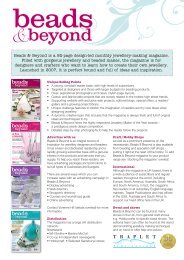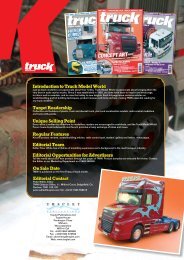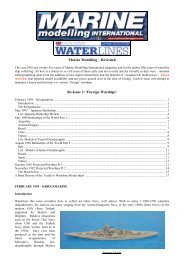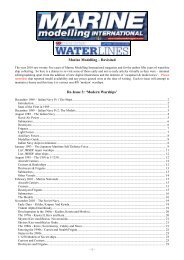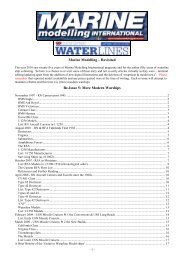here - Traplet Publications
here - Traplet Publications
here - Traplet Publications
You also want an ePaper? Increase the reach of your titles
YUMPU automatically turns print PDFs into web optimized ePapers that Google loves.
Coamings made from strips of 3.0 mm thick ply approximately 15<br />
mm wide were made to fit round the hatch opening, measurement<br />
of this opening and the fit of the coamings was critical as the premade<br />
hatch had to be a sliding fit after all parts had been painted.<br />
The coamings were reinforced at each corner with triangles of 3.0<br />
mm thick ply and they were painted by brush with acrylics mixed<br />
to a dull red. The hatch was tried in place and found to fit; it gave<br />
a large opening, when removed, allowing easy access to the radio<br />
equipment, motor, speed controller and switches etc.<br />
Progressively the remainder of the decks were made from 3.0 mm<br />
plywood and fitted in place over suitable beams. It was found that<br />
the fibreglass hull had spread slightly and a pair of long, adjustable<br />
clamps was used to hold the hull sides until the beams and glue<br />
were firmly fixed. All the decks were treated with two coats of<br />
sanding sealer and sanded smooth once fitted. The after deck was<br />
cut away in way of the superstructure and low coamings were fitted<br />
made from strips of 3.0 mm plywood. Beneath this area a platform<br />
was made from 3.0 mm plywood over the propeller shaft and on<br />
this was fitted a battery pack of four 1.2 mmM cells to feed the<br />
navigation lights and a suitable on/off switch was also fitted <strong>here</strong>, in<br />
circuit with the battery pack and lighting harness.<br />
SUPERSTRUCTURE<br />
The superstructure was built from 1.5 mm plywood to fit<br />
accurately over the coamings and was of a simple box construction<br />
except for the wheelhouse. So frequently, when fitting glaZing, glue<br />
spreads and mars the clear material. On this occasion I decided<br />
to build the wheelhouse walls in three layers to allow glazing to<br />
slide into place, glue free, and to be held securely when the roof<br />
was glued on. The inner and outer walls were cut to show the full<br />
size of the window apertures. the middle section of the walls was<br />
cut smaller than the outer and inner sections by enough to allow<br />
the glazing to slide between the outer sections. All three individual<br />
wall sections were then glued firmly together and prepared for<br />
staining and varnishing before being assembled. The result can be<br />
seen in the photographs<br />
ABOVE: Stern view showing construction of aft superstructure<br />
Inside the wheelhouse were fitted, a wheel on a stand and complete<br />
with chain and pulley, binnacle and telegraph, all from the Mobile<br />
Marine Models range and a chart table complete with chart was<br />
made and.fitted to the port side of the wheelhouse.<br />
The funnel was carved and sanded from a block of jelutong to<br />
match the drawings. The wheelhouse roof was prepared next.<br />
painted and fitted with navigation lamps and casings, the lamps of<br />
LED's, from Mobile Marine Models, were fitted and white styrene<br />
tubes were added beneath the lamps to conceal the cables that led<br />
through the wheelhouse. The wheelhouse doors were fitted with<br />
small brass hinges purchased from Squires. and can be opened or<br />
closed as required. Aft of the funnel housing are two water tanks<br />
and a skylight and further aft is the quadrant over the rudder with<br />
operating chains in place. Tubes for the rudder operating units run<br />
on either side of the engine room casing. Above the aft tanks etc.,<br />
are two frames upon which the lifeboat is mounted and a small<br />
ABOVE: View inside wheelhouse showing wheel, steering chain<br />
with gypsy and telegraph<br />
ABOVE: Stern end of superstructure<br />
base illustrating rudder quadrant with<br />
steering chain<br />
ABOVE: Main mast lower showing pivot<br />
arrangement<br />
for derrick<br />
ABOVE:<br />
slewing<br />
Base of main mast illustrating<br />
winch<br />
www.rnarinernodelmagazine.com FEBRUARY 2010 57



